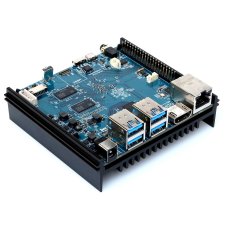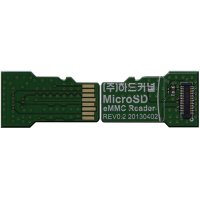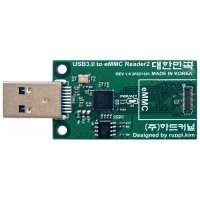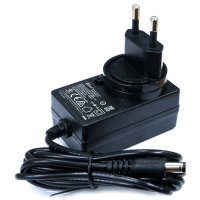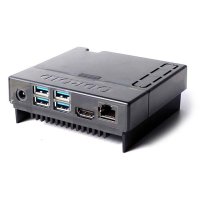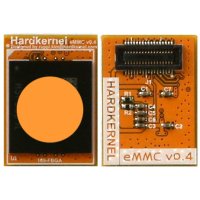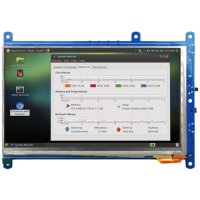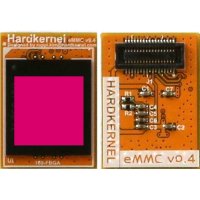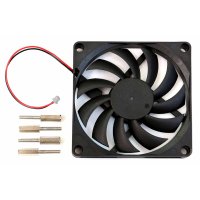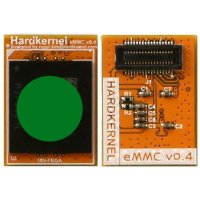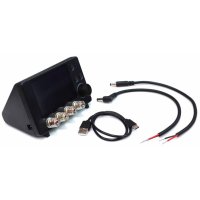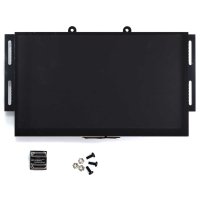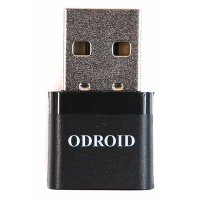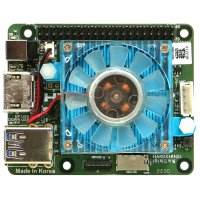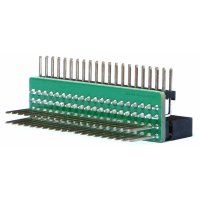- Maximum CPU clock of Quad-core Cortex-A73 is increased to 2.4Ghz from 1.8Ghz.
- Maximum CPU clock of Dual-core Cortex-A53 is increased to 2.0Ghz from 1.9Ghz.
- On-board RTC backup battery holder is mounted on the board.
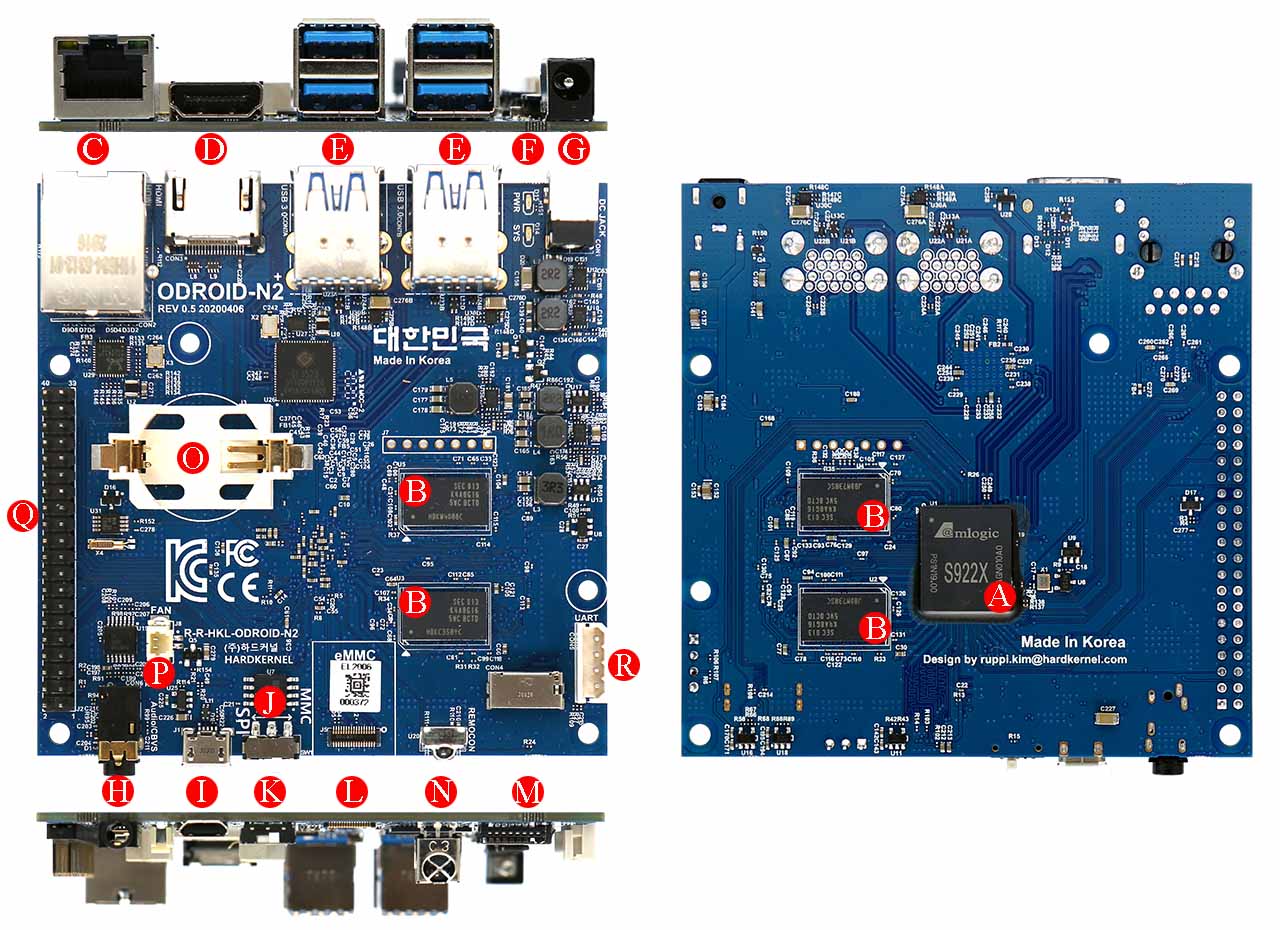
| A | S922X CPU | J | 1 x SPI Flash 8MiB |
| B | 4 x DDR4 RAM | K | 1 x SPI Boot Select Switch |
| C | 1 x RJ45 Ethernet Port (10/100/1000) | L | 1 x eMMC Module Socket |
| D | 1 x HDMI 2.0 | M | 1 x Micro SD Slot |
| E | 4 x USB 3.0 | N | 1 x IR Receiver |
| F | 2 x System LED Indicators | O | 1 x RTC Backup Battery Holder |
| G | 1 x DC Power Jack | P | 1 x Active Cooling Fan Connector (2-pin) |
| H | 1 x AV Out (Stereo Audio with Composite video) | Q | 40 x GPIO Pins |
| G | 1 x DC Power Jack | R | 1 x UART for System Console |
| H | 1 x AV Out (Stereo Audio with Composite video) | ||
| I | 1 x Micro USB2.0 OTG |
Optional Active Cooler
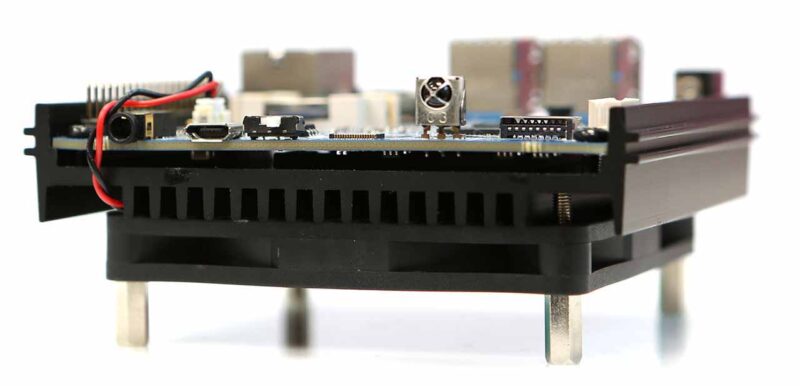
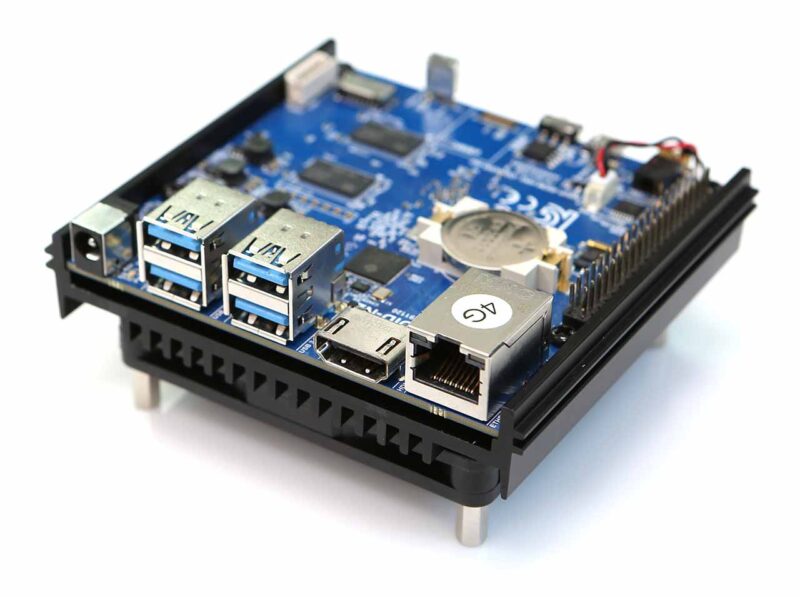
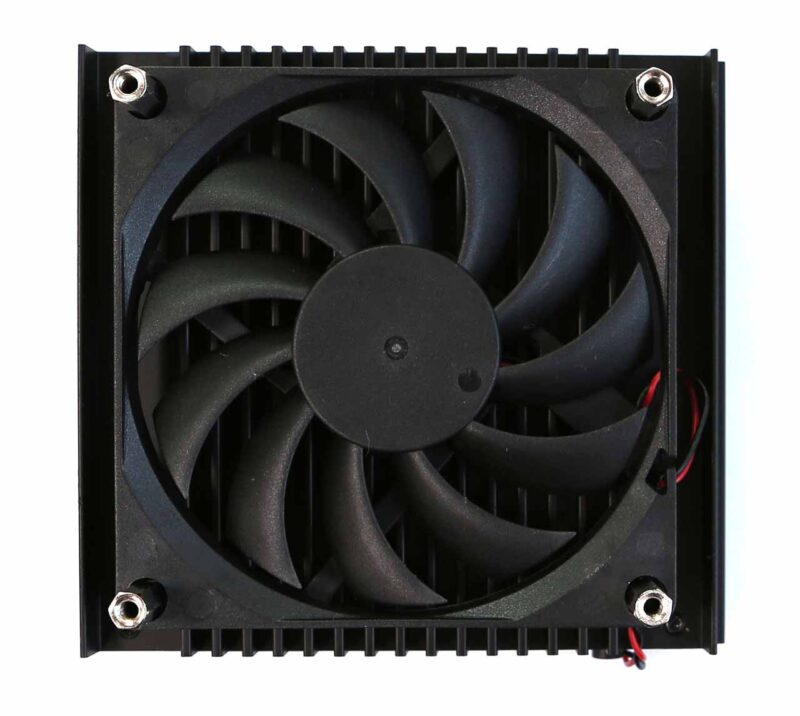

N2 block diagram

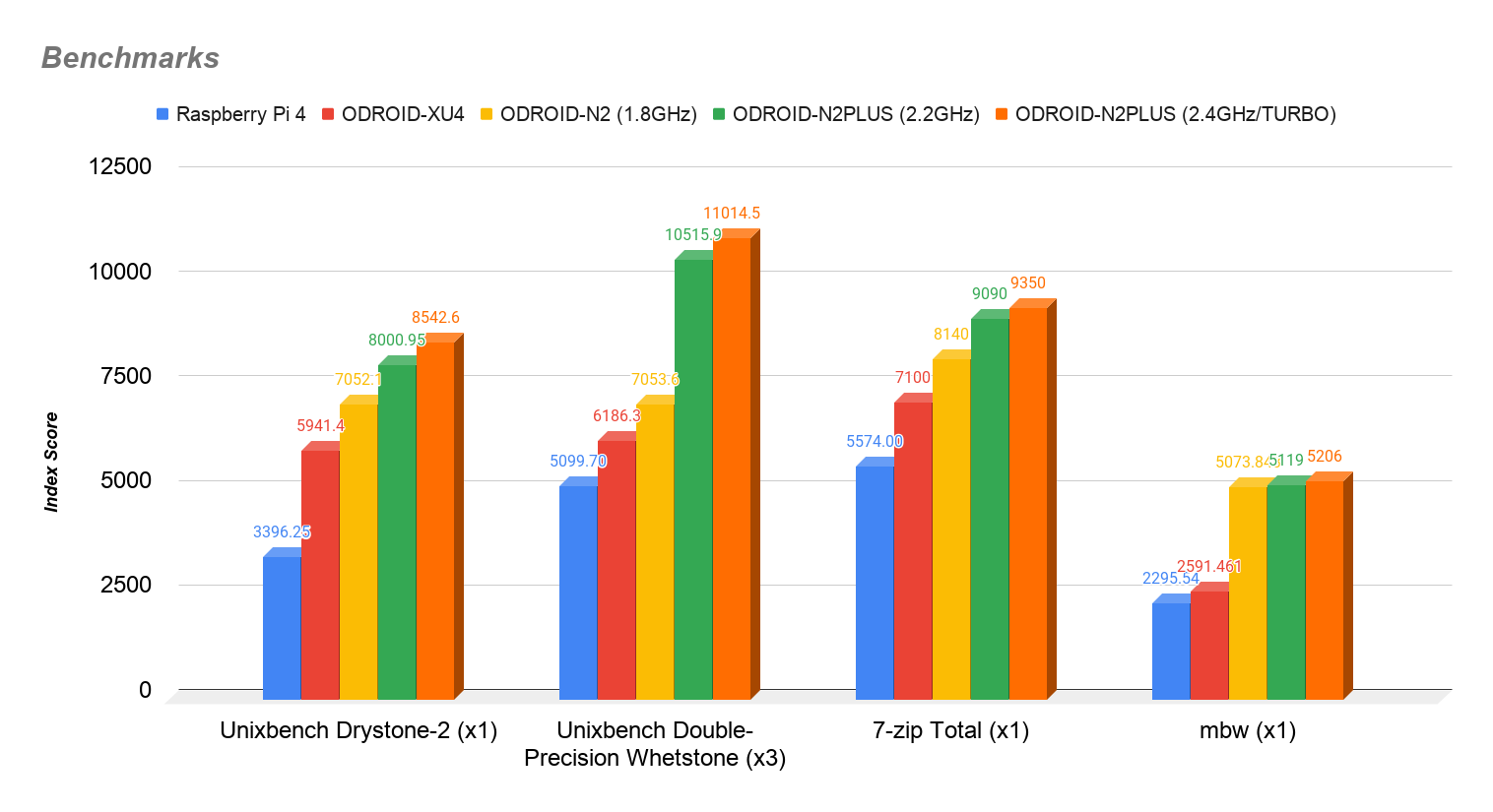
- The Mali-G52 runs at 800Mhz and is ~10% faster than Mali-T860MP4 in ODROID-N1.
- The Mali-G52 is the second Bifrost-based mainstream GPU from Arm.
- There are two Shader Processors in the GPU and each core has three Execution Engines. This is sometimes referred to as MP6.
- GPU performance was measured with glmark2-es2 “–off-screen” option.


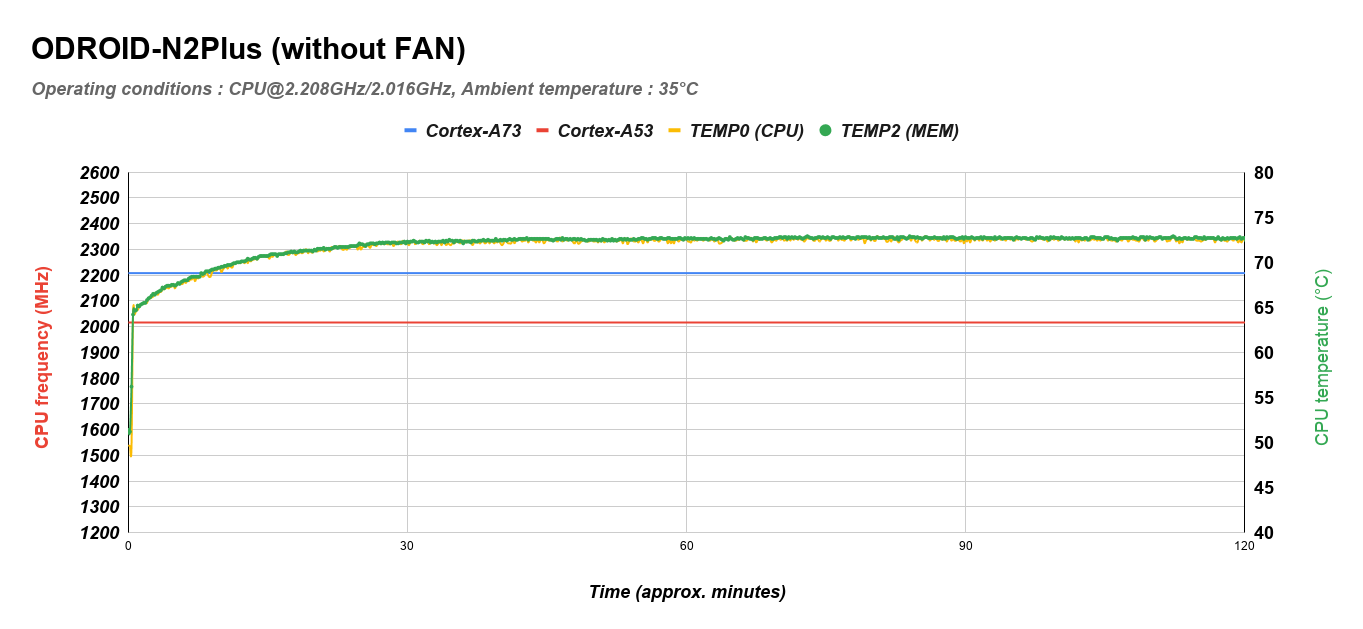
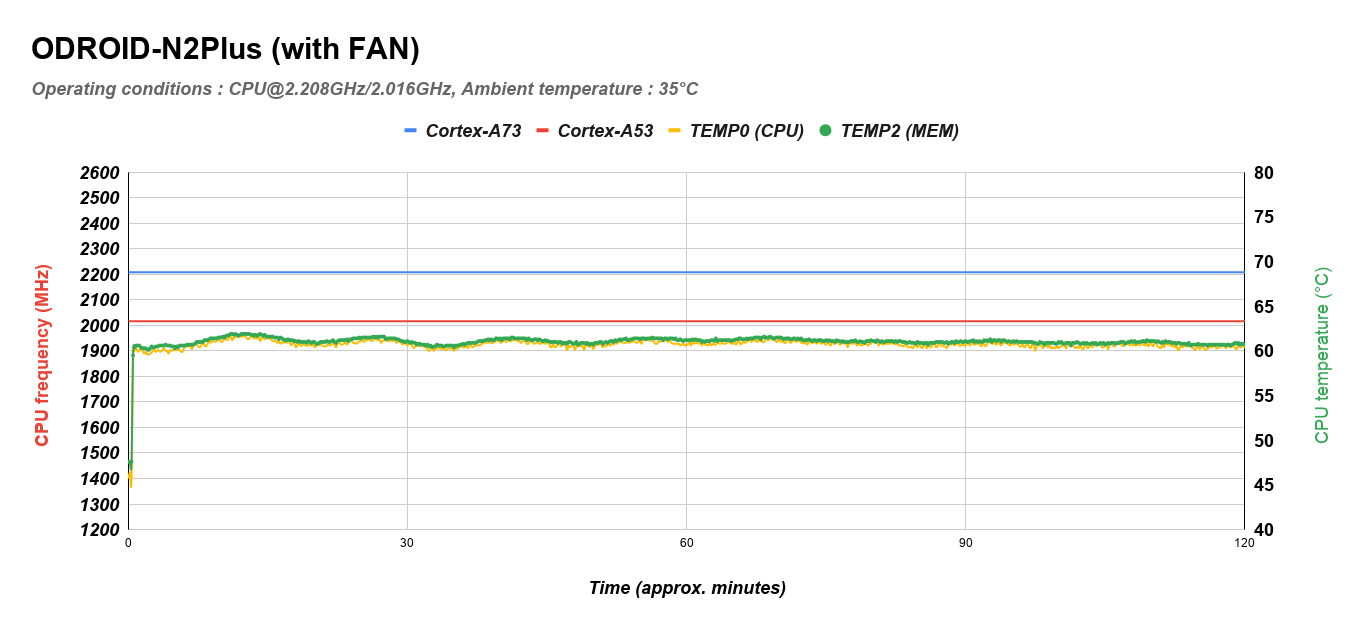
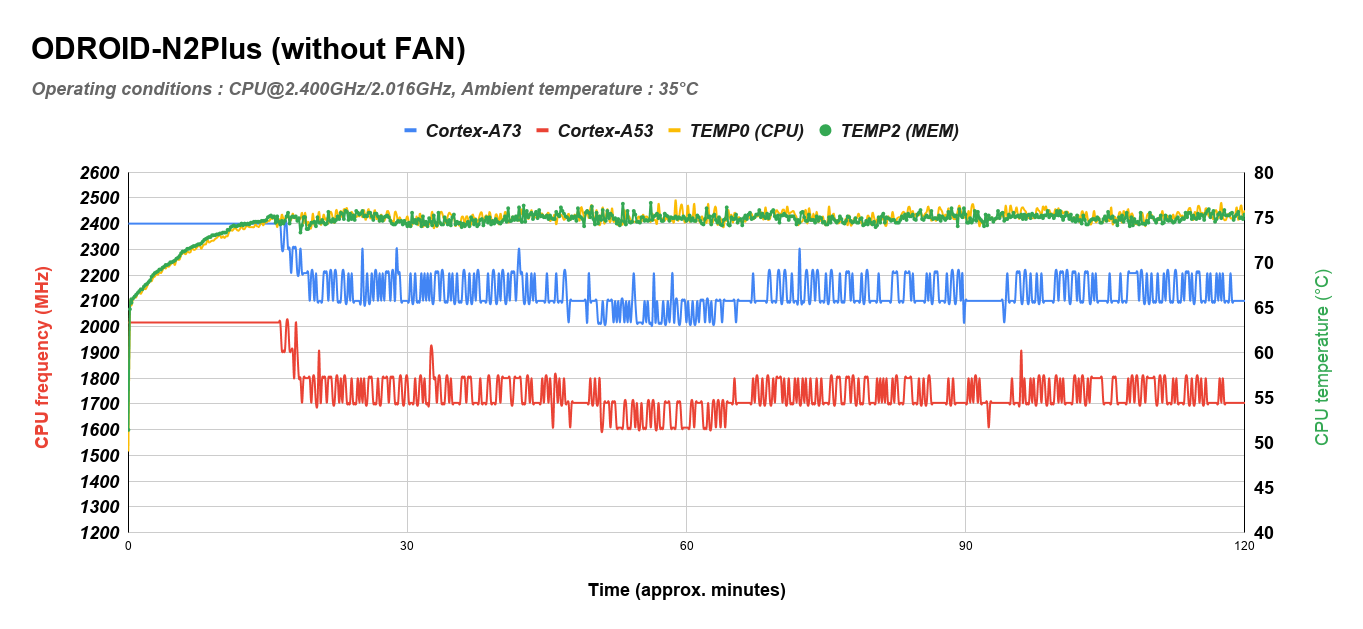
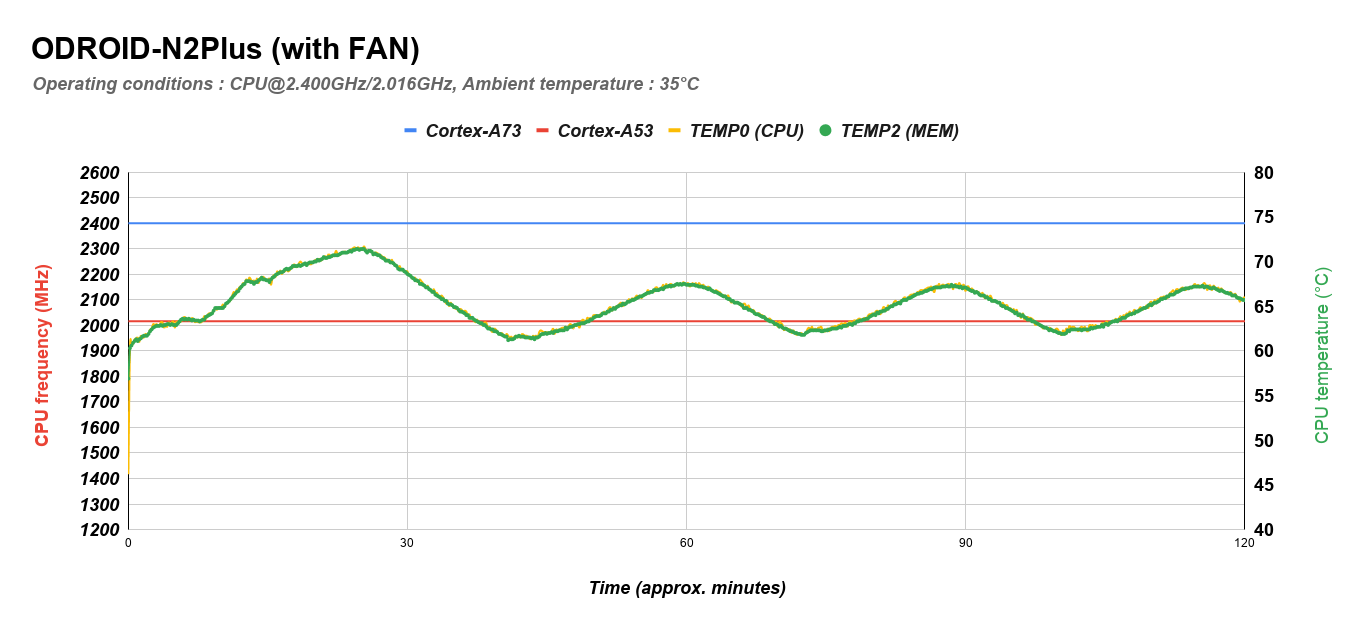
Gbit Ethernet
According to our iperf test result, the throughput performance was near 1Gbps.

eMMC storage performance
Sequential read and write speed is over 150MB/s and 125MB/s respectively.
4K random access performance is reasonably fast too. iozone test result are as follows.

Micro-SD UHS performance
Using properly implemented UHS dynamic voltage scaling, the sequential read and write speed is over 70MB/s and 55MB/s respectively.

Sound DAC




- Idle state: 1.6~1.8 Watt
- Heavy load state: 5.9~6.2 Watt (stress-ng –cpu 6 –cpu-method matrixprod)
- No cables are attached except DC power input and USB-UART debug console cable.
- Ubuntu 20.04 LTS images are available with Kernel version 4.9.230 LTS as of today. This LTS kernel version will be officially supported until Jan, 2023.
- The Mali G52 GPU Linux driver works only on the framebuffer and Wayland. We tested the latest PPSSPP emulation and it can handle x3 scaling on a 4K
display nicely with well implemented VSYNC.
- The fb-dev Mali driver supports OpenGL-ES 1.1, 2.0, 3.0 and 3.1 as well as OpenCL-1.2 and 2.0 at this moment. Note that you have to use the Minimal Ubuntu
OS image to utilize the GPUacceleration instead of the Ubuntu Mate image.
- Board Dimensions: 90mm x 90mm x 17mm
- Heatsink Dimensions: 100mm x 91mm x 18.75mm
- Weight: 200g including heatsink
- Amlogic S922X Processor (12nm fab)
- Quad-core Cortex-A73(up to 2.4Ghz) and Dual-core Cortex-A53 (up to 2Ghz)
- ARMv8-A architecture with Neon and Crypto extensions
- Mali-G52 GPU with 6 x Execution Engines (800Mhz)
- DDR4 4GiB or 2GiB with 32-bit bus width
- Data rate: 2640 MT/s (PC4-21333 grade)
- 1.2Volt low power design
- 1 x eMMC connector (8G, 16G, 32G and 64G are available)
- 1 x microSD slot (DS/HS modes up to UHS-I SDR104)
- 1 x GbE LAN ports (RJ45, supports 10/100/1000 Mbps)
- Realtek RTL8211F (Ethernet transceiver)
- LED indicators
- Green LED: Flashing by data traffics at 100Mbps connection
- Amber LED: Flashing by data traffics at 1000Mbps connection
- Optional WiFi USB adapters
Video
- 1 x HDMI 2.0 (up to 4K@60Hz with HDR, CEC, EDID)
- 1 x Composite video (3.5mm jack)
Audio
- 1 x Stereo Audio line-out (3.5mm jack)
- 1 x HDMI digital output
- 1 x Optional SPDIF optical output
External
- I/O 4 x USB 3.0 Host ports (shares one single root hub)
- 1 x USB 2.0 OTG port for Host or Device mode. (No power input)
- 1 x Debug serial console (UART)
- 1 x Peripheral Expansion Header (40-pin, 2.54mm pitch)
- 2 x DC 5V, 2 x DC 3.3V, 1 x DC 1.8V, 8 x GND
- 1 x SPI
- 1 x UART
- 2 x I2C
- 25 x GPIO (Max)
- 2 x ADC input (10bit, 1.8V Max)
- All 3.3V I/O signal level except for ADC input at max 1.8Volt.
- On board RTC(Real Time Clock) IC to keep date and time. A CR2032 coin battery holder was replaced with the 2-pin 1.25mm pitch connector.
- No battery is included in the board.
- Please purchase the very common bare CR2032 cell from your local store.
- You can keep the RTC time up to several years with a 200mAh CR2032 battery.
- 8MiB SPI Flash for boot manager
- IR receiver for remote controller
- Built with a large passive heatsink
- System LEDS Indicators:
- – Red (PWR) – Solid light when DC power is connected
- – Blue (ALIVE) – Flashing like heartbeat while Kernel is running.
- Active Cooling Fan Connector (5V 2-pin)
- – Connector (2-pin, 1.25mm pitch)
- 1 x DC jack : outer (negative) diameter 5.5mm, inner(positive) diameter 2.1mm
- DC 7.5V ~ 18V (up to 25W)
- DC 12V/2A power adaptor is recommended
- Power consumption:
- IDLE : ≃ 2.2W (Performance governor)
- CPU Stress : ≃ 5.9W (@2016/2208MHz), 6.2W (@2016/2400MHz)
- Power-off : ≃ 0.2W
Note:
The supplier of the product has no replacement and/or refund policy as part of their product warranty/guarantee. Furthermore, the repair cost and the cost of shipping to and fro from South Korea has to be borne. As Fab.to.Lab is merely an intermediary we extend the exact same warranty terms to all customers of Harkernel.
Please find more details here: Supplier warranty terms and conditions: https://www.hardkernel.com/agreement/
| Processor Specifications | |
| Processor | Amlogic S922X Processor (12nm fab) |
| Number of Cores | Quad-core Cortex-A73(up to 2.4Ghz) and Dual-core Cortex-A53 (up to 2Ghz) |
| Architecture | ARMv8-A architecture with Neon and Crypto extensions |
| GPU | Mali-G52 GPU with 6 x Execution Engines (800Mhz) |
| Memory Specifications | |
| RAM | DDR4 4GiB or 2GiB with 32-bit bus width |
| Connectivity | |
| Ethernet | 1 x GbE LAN ports (RJ45, supports 10/100/1000 Mbps) |
| Electrical Specifications | |
| Input Power | DC 7.5V ~ 18V (up to 25W) |
| Physical Attributes | |
| Weight | 200g including heatsink |
| Size | Board Dimensions: 90mm x 90mm x 17mm Heatsink Dimensions: 100mm x 91mm x 18.75mm |
| Additional Information | |
| Warranty | |
Odroid-N2+
- Brand: Hardkernel
- Product Code: Hdk-Odroid-N2+
- Reward Points: 90
- Availability: In Stock
- रo 8,679.00
-
रo 7,531.00
- Price in reward points: 8966
-
- 2 or more रo 8,607.00
- 3 or more रo 8,571.00
- 8 or more रo 8,535.00
- 15 or more रo 8,464.00
Available Options
Related Products
eMMC Module Reader Board for OS update
This is the only way that you can upgrade your OS in the eMMC. It is highly recommended item. ..
रo 197.00
USB3.0 eMMC Module Writer 2
Easier and faster way to flash your OS image into the eMMC Module. With this unit, you will not need..
रo 1,302.00
Power supply 12V/2A
Note: In the above power supply is suitable for ODROID-C4, ODROID-HC2, ODROID-M1, ODROID-..
रo 818.00
Odroid-N2/N2+ Case
For those who wants to protect the ODROID-N2/N2+ board from dust and the elements. Strong & ..
रo 526.00
eMMC Module for H-series
8GB / 32GB / 64GB (eMMc Module)16GB eMMC module uses both eMMC 5.1 chipset and the Phison eMMC chips..
रo 1,302.00
ODROID-VU7A Plus: 7inch HDMI display with Multi-touch and Audio capability
The ODROID-VU7A Plus is your new 7-inch multi-touch screen for the ODROIDs with audio capability!7-i..
रo 9,599.00
eMMC Module N2 - Linux
OS Preinstalled Ready to run out of the box eMMC storage performance : Sequentia..
रo 1,302.00
80x80x10.8mm Cooling Fan with 2pin JST connector
80x80x10.8mm cooling fan with 2pin JST connector for Odroid N2 and N2+. Specification..
रo 526.00
eMMC Module N2 - Android
OS Preinstalled Ready to run out of the box eMMC storage performance : Sequential re..
रo 1,302.00
ODROID SmartPower 3
The easy way to make a Green platform. The ODROID Smart Power3 is an easily deployable power supply ..
रo 2,959.00
ODROID-VU7C 7inch 1024×600 HDMI display with multi-touch
Add a display on an ODROID-C4 without any cable by plugging it into the 40pin female header on the b..
रo 7,232.00
WiFi Module 5BK
WIFI Module #5BK uses the same chipset (Realtek RTL8821CU) as WIFI Module #5B, so it is 100% compati..
रo 1,170.00
ODROID-N2L
The low-cost variant of our most popular and powerful ARM SBC ODROID-N2+. This project was actu..
रo 6,604.00 रo 7,758.00
40pin GPIO Dual Edge connection board
GPIO Dual Edge connection is a board that leads the 40Pin GPIO pins of the ODROID out of convenient ..
रo 855.00
Tags: Odroid-N2+, SBC, Cortex-A73

